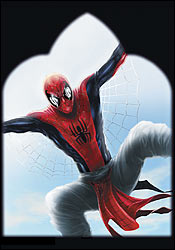
Kipling, who wrote “East is East and West is West, and never the twain shall meet,” would doubtless raise a bushy eyebrow at the news that Marvel Comics and Gotham Entertainment will soon be launching an Indian version of Spider-Man. Farewell, Peter Parker; namaste, Pavitr Prabhakar. His fiefdom is the mean streets of Mumbai (formerly Bombay) instead of Manhattan. When crisis calls, he still dons his Spidey bodysuit, but he also sports a billowing dhoti and a pair of snazzy curl-toed slippers on his feet. The Green Goblin, his chief enemy, now takes the form of a rakshasa, a demon drawn from Indian mythology.
On chat boards and across the blogosphere, comics fans have been competing with each other to see who is the most indignant. It’s claimed that Spider-Man’s purity will be sullied. That he’s a uniquely American superhero. That the very idea of Indian graphic fiction is a bit of a joke. Funny—people used to scoff at Japanese anime. Aside from the absurdity of being a purist about one of pop culture’s most pleasingly bastard and vulgar forms, those carpers, if they’re to be consistent, should bemoan the popularity of Indian religious iconography and henna motifs among Western fashionistas. Cultural exchange is a two-way process.
The Indianization of Spider-Man has precedents. Hindi cinema has a long history of borrowing and adapting from Western sources, be they Busby Berkeley dance routines in the thirties, Chaplin-like heroes in the common-man social epics of the fifties, or Dirty Harry, a major influence on the wildly popular revenger tragedies of superstar Amitabh Bachchan. Now, following broadcasting deregulation, young children are able to watch everything from Rugrats to Wallace & Gromit on cable TV. Spider-Man 2 is currently breaking box-office records around the globe, and it is likely to top Titanic’s record in India.
“It’s absurd to be a purist about one of pop culture’s most pleasingly bastard and vulgar forms.”
India has its own comic-book traditions, too. Most bus shelters and train stations stock Amar Chitra Katha, a series of historical and mythological strips based on the stories of Rama. One of the most popular superheroes of the seventies was a shaggy-haired, bell-bottom-wearing dude called Bahadur. In April, Penguin Books India published the country’s first graphic novel, Sarnath Banerjee’s Corridor, which is already into a second printing. Hollywood animation companies have begun to outsource creative work to the subcontinent, where they can rely on a steady pool of ex–street painters whose former livelihoods waned because of crackdowns in illegal advertising and the rise of photography in film posters.
If the creative talent needed to bring an Indian version of Spider-Man to life is almost in place, so is the social context. Metropolis, Gotham City, Opal City—comics were both a product of and a commentary on the twentieth-century American city in all its exhilaration, capitalist energy, and sprawling loneliness. Until recently, India didn’t have enough urban breeding grounds for would-be superheroes.
Now, though, market forces and neo-liberal economics have made Mumbai a boom city. Tens of thousands of villagers migrate there each year; middle-class affluence is in your face; the skyline is pocked with high-rises, radio masts, and multinational office blocks. Marvel’s suggestion that an Indian Spider-Man would swing from rickshaws and scooters is a quaint one; the architecture of metropolitan modernity is already there. Prabhakar himself should be a call-center worker, a geek scientist, or an underpaid HTML coder at the bottom of the globalized knowledge economy to which Mumbai belongs. His inability to demonstrate his love for his sweetheart would play very well in a nation where representations of physical affection are still circumscribed.
But perhaps it’s the phrase “With great power comes great responsibility” that may travel the best. While it may seem distinctly American—the sentiment speaks to an era in which many people believe the U.S. is flexing its imperial might a little too recklessly—it also reverberates abroad. It has considerable resonance in India, where, notwithstanding the recent election of the left-leaning Congress Party, the country is still recovering from years of the nationalist BJP Party, which seemed hell-bent on nuclear war. Even now, the Delhi and Kolkata equivalents of J. Jonah Jameson’s Daily Bugle are chronicling public disquiet over dubious hydro projects, governmental corruption, and the ever-widening gulf between rich and poor. No better swinging ground could exist for an urban hero—however metaphorical.